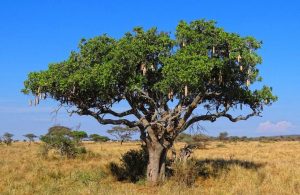Vernonia amygdalina, family Astaraceae, is a medicinal herb commonly known as bitter leaf. This plant is indigenous to tropical Africa and has enormous medicinal uses and is regarded as a gold mine by many African communities.
The plant is normally found along rivers and lakes, in forest margins, wood land and open grass land in the wild or cultivated. It grows very well under full sunlight and humid environmental conditions. The Vernonia amygdalina plant is a shrub that grows to a height of 1-3 m with petiole leafs of about 6 mm in diameter and about 20 cm long, and elliptic in shape.
The leaves are dark green colored with a characteristic odour and have a bitter taste. The bark is grey or brown and has a rough texture that is flaked. Its flowers are white, small, tiny, and clustered with small fruits that are slightly hairy, with small nuts inside. Although the bitter leaf plant has been harvested in the wild for centuries, some communities have taken the initiative to grow it on farms. This is because herbal clinics are emerging that use it widely as an ingredient in the herbal formulations and also because of its demand as a vegetable in some communities.
This bitter leaf plant is propagated by seeds and stem cuttings. Communities or traditional healers collect the seeds from dry flower heads and first plant them in nursery beds to produce seedlings that can be transplanted 4-6 weeks after their emergence. Nevertheless, stem cuttings are also used in the propagation of bitter leaf plants since they can grow faster. The cuttings are planted in an erect manner or slanted at an angle to obtain more side shoots. Harvesting of the plant is preferred in the rainy seasons, since it allows the new leafy shoots to grow for another harvest, a few weeks later. In the dry season, only the leaves of the plant are harvested without cutting the shoot since there is a scarcity of water for the plant to re-grow.
Bitter leaf has been used as food and medicine for centuries in Africa. The plant has a wide spectrum of uses in African traditional medicine and has been used in the management and treatment of a number of health conditions. For instance, African Traditional Healers across the African continent use the plant for treating and managing a number of medical conditions including: fever, malaria, stomach ache, skin infections like ringworm, acne, diabetes, cancer, insomnia, hepatitis, toothache, jaundice, diarrhea, bilharzias, pneumonia, tuberculosis, stroke, arthritis, wounds, fatigue and cough. It is also used as an anti-parasitic, anti-bacterial, anti-inflammatory and anti-helminthes, as a laxative, an appetizer, an aphrodisiac and for body weight loss.
The plant parts are prepared in different ways to treat different ailments. For example, the roots of the plant are pounded and boiled with water to make a decoction for treatment of stomach and gastrointestinal problems, while the decoction from the leaves is used in treating malaria, fever and cough. A traditional healer can prescribe a prepared decoction dose for the patients based on the type and extent of the sickness.
In some communities, the stems of the bitter leaf are used as chew-sticks for oral hygiene, and for the management of some dental problems. The sap from the leaves can also be squeezed out and mixed with a small quantity of water and drunk twice daily to treat stomach upsets.
Bitter leaf has also been used in gynaecological situations by the traditional birth attendants (TBAs). The traditional birth attendants are elderly women in rural villages in Africa who help expectant mother to deliver in their homes. These TBAs prepare a leaf decoction which is given to the mothers to cause the expulsion of the placenta after birth, aid post-partum uterine contraction, induce lactation and control post-partum haemorrhage. The leaf decoction is recommended by traditional healers and TBAs for breast feeding mothers to take regularly to increase milk production and quality.
Some small and medium scale industries use bitter leaf in their herbal soap formulations, and in beer brewing which is drunk for restoration of stamina.
In some African communities, the leaves of the plant form part of their diet. The leaves are prepared by boiling with water but the water is changed at intervals till all the traces of bitterness is washed off; then the less bitter boiled leaves are added to a given sauce and spiced according to ones taste. Nutritionally, bitter leaf is one of the leafy vegetables that have been used to alleviate the problems of micronutrients, malnutrition as it is exceptionally rich in proteins, vitamins and mineral elements including iron, phosphorus, calcium, potassium, zinc, copper, folic acids and ascorbic acid
Scientific studies show that Vernonia amygdalina is rich in bioactive compounds such as alkaloids, saponins, terpenes, flavanoids, phenolic acids that have various medicinal properties including cancer prevention and treatment of microbial infections. Some of these bioactive compounds like alkaloids contribute to the bitter taste of this wonder plant.
In conclusion, the wide spread medicinal and food uses of Vernonia amygdalina make this important plant be kept close to the hearts of African communities.
– Komakech Richard & Omujal Francis






